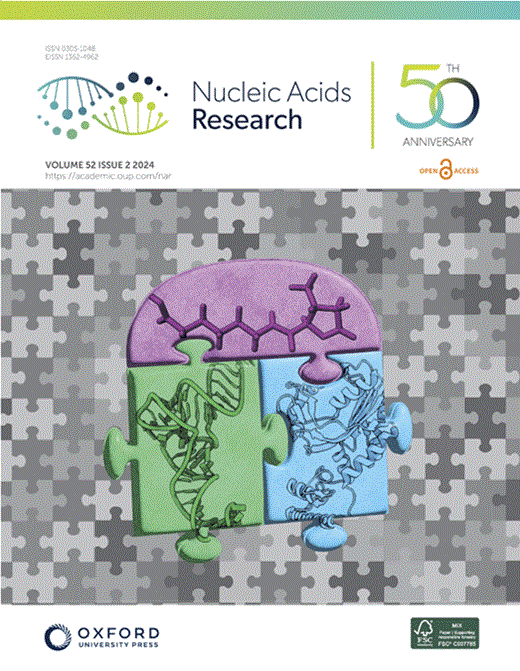eb - na领导蛋白在eb病毒诱导的B细胞转化过程中协调染色质结构重塑
IF 13.1
2区 生物学
Q1 BIOCHEMISTRY & MOLECULAR BIOLOGY
引用次数: 0
摘要
Epstein-Barr病毒核抗原先导蛋白(EBNA-LP)在eb病毒(EBV)转化B细胞中起关键作用,独立于EBNA2调控染色质结构和基因表达。我们的研究表明,ena - lp结合到与EBNA2不同的染色质区域,并通过与细胞因子YY1相互作用促进长距离染色质环的形成。这种相互作用重新配置了宿主基因组的三维结构,增强了拓扑相关结构域(TADs)的完整性,并促进了这些结构域中增强子和启动子之间的相互作用。在ebv感染的B细胞中,EBNA-LP加强了TADs中yy1介导的染色质环,这有助于维持B细胞转化所必需的稳定调控程序。值得注意的是,EBNA-LP对于建立ebv诱导的增强子至关重要,但一旦形成就不需要维持它们。此外,我们的数据表明,在缺乏ena - lp的情况下,CTCF结合的代偿性增加,导致TAD之间的染色质相互作用更加混杂,TAD边界的绝缘减少。这些发现为EBV重塑宿主基因组染色质结构以支持B细胞转化的分子机制提供了新的见解,并强调了破坏EBV驱动的肿瘤发生的潜在治疗靶点。本文章由计算机程序翻译,如有差异,请以英文原文为准。
EBNA leader protein orchestrates chromatin architecture remodeling during Epstein-Barr virus-induced B cell transformation
Epstein-Barr virus Nuclear Antigen Leader Protein (EBNA-LP) plays a pivotal role in the transformation of B cells by Epstein-Barr virus (EBV), functioning independently of EBNA2 to regulate chromatin architecture and gene expression. Our study reveals that EBNA-LP binds to chromatin regions distinct from EBNA2 and facilitates the formation of long-distance chromatin loops by interacting with the cellular factor YY1. This interaction reconfigures the three-dimensional structure of the host genome, enhancing the integrity of topologically associating domains (TADs) and promoting the interaction between enhancers and promoters within these domains. In EBV-infected B cells, EBNA-LP strengthens YY1-mediated chromatin loops within TADs, which helps maintain stable regulatory programs essential for B cell transformation. Notably, EBNA-LP is crucial for establishing EBV-induced enhancers, yet it is not required for their maintenance once formed. Additionally, our data suggest a compensatory increase in CTCF binding in the absence of EBNA-LP, leading to more promiscuous chromatin interactions between TADs and a reduced TAD insulation at their boundaries. These findings provide new insights into the molecular mechanisms by which EBV reshapes the host genome chromatin architecture to support B cell transformation and highlight potential therapeutic targets for disrupting EBV-driven oncogenesis.
求助全文
通过发布文献求助,成功后即可免费获取论文全文。
去求助
来源期刊

Nucleic Acids Research
生物-生化与分子生物学
CiteScore
27.10
自引率
4.70%
发文量
1057
审稿时长
2 months
期刊介绍:
Nucleic Acids Research (NAR) is a scientific journal that publishes research on various aspects of nucleic acids and proteins involved in nucleic acid metabolism and interactions. It covers areas such as chemistry and synthetic biology, computational biology, gene regulation, chromatin and epigenetics, genome integrity, repair and replication, genomics, molecular biology, nucleic acid enzymes, RNA, and structural biology. The journal also includes a Survey and Summary section for brief reviews. Additionally, each year, the first issue is dedicated to biological databases, and an issue in July focuses on web-based software resources for the biological community. Nucleic Acids Research is indexed by several services including Abstracts on Hygiene and Communicable Diseases, Animal Breeding Abstracts, Agricultural Engineering Abstracts, Agbiotech News and Information, BIOSIS Previews, CAB Abstracts, and EMBASE.
 求助内容:
求助内容: 应助结果提醒方式:
应助结果提醒方式:


